[ad_1]
Travel
Text and Photographs by Vanya Lochan.
We get to feel and that makes us the lucky ones…. So, far from simply existing, we can choose to keep reimagining and evaluating the quality of our existence. Improvement, I believe, is not just about the ease of materially enhancing our lives; it can also be found, as I learnt a few weeks ago on a trip to Six Senses Fort Barwara, by simply acknowledging small things that matter, and reconnecting meaningfully with what’s around us.
Excerpts from my travel diary….
Day 1: Arrival
I look forward to a lively afternoon as I land in Jaipur to a royal welcome by Baboolalji, Six Senses’ ever-so-punctilious concierge. Handling my luggage with ease — as if my overpacking didn’t weigh anything at all — he leads me to the hotel’s black Toyota Vellfire. Just three minutes in the car and I am already soaking in the vanilla and lavender scents of Six Senses. I share my seat with a little jute potli (packet) containing eco-friendly hand cream, sanitiser and lip balm. Baboolalji offers me a bottle of cold juice and draws my attention to the trail mix placed within the armrest of my seat. As we drive out, I naturally get to a topic that has been on my mind since my trip here was planned: the big Bollywood wedding that had taken place at the resort a year ago. It doesn’t take more than a mere mention to coax him to chat about the starry event.
“Katrina Kaif sat in this car — the same place as you — but another driver was on duty that day. I drove Vicky [Kaushal] Sir and his brother [Sunny Kaushal] though! Vicky greeted me, then listened to his own music through the ride. Would you like to plug in your music?” he asks me.
I choose, rather, to chat about historical anthropology.
As we find ourselves farther from Jaipur (the airport is on the outskirts of the town), the conversation veers to his family and interesting myths from the area. I am regaled with tales of massive forts and serais (resting quarters) in and around Ranthambore, brave Rajasthani kings and Delhi sultans, mysterious goddesses, and queens who committed jauhar (self-immolation). Stories about dhonk (a small hardy tree or shrub found in the Aravalli Hills) and banyan trees (“barwara” means “home of the banyan” in Marwari) keep me occupied, and even though I later hear the official history of the place from the head naturalist, Baboolalji’s version — the one ensconced in the memories of the locals — remains far more fascinating. Our vehicle is eating up the miles and by the time darkness begins to set in, we find ourselves on a hill, ready to be welcomed inside the fort with a chant and the ring of a bell, a greeting that reinforces the popular belief “atithi devo bhava” (guests are like gods).
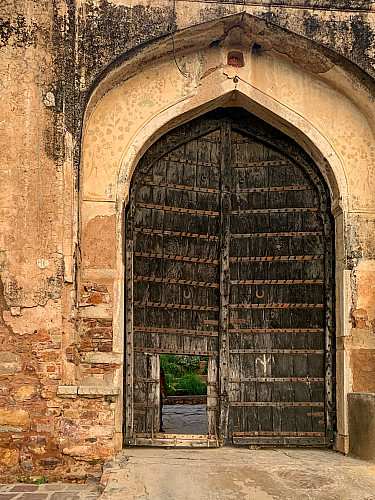
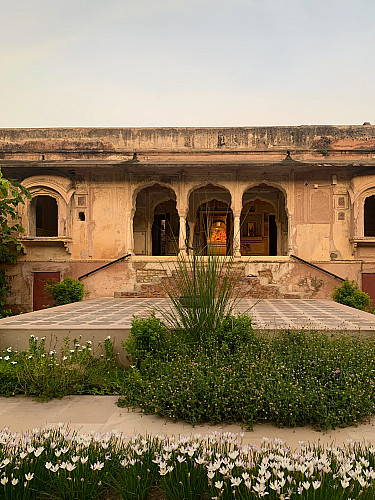
My Guest Experience Maker (GEM), Shweta Yadav, takes me to the Aravali View Suite (bring it to Mumbai and it could morph into a decent-sized apartment!). I read General Manager Frans Westraadt’s letter: “To reinterpret the regal ambience of a bygone era dating back 700 years…Six Senses Fort Barwara [originally a 14th-century fort] has been sensitively transformed by a team of archaeological restoration experts into a 48-suite resort in a conservation effort that has taken more than a decade to complete.”
It’s after a rather detailed chat with architect Parul Zaveri, and another one with the scion of the fort, Prithviraj Singh, that I begin to fully understand the decade-long labour that went into the construction of this lavish resort. But at that time, even as I put down Frans’ letter promising me an opportunity at reconnection that goes from “yum to Ommm…”, I come across another one penned by Shweta that warms my heart beyond measure.
Tucking both the letters inside my burgundy notebook, I turn my attention to the splendour of my suite. Next to the all-natural welcome snacks and drinks, there’s a remote to the automatic window screen, which takes me to my personal garden with beds of beautiful autumn zephyr lilies.
The elegant cotton bedding finely balances the polished amber of the floor, and every inch of the embroidered buttress promises to drown one in resplendence. My attention is grabbed by the raw stone wall on the right corner with a window that opens into the garden. My delight knows no bounds when I discover the marble bathtub, a closed showering space and an open shower.
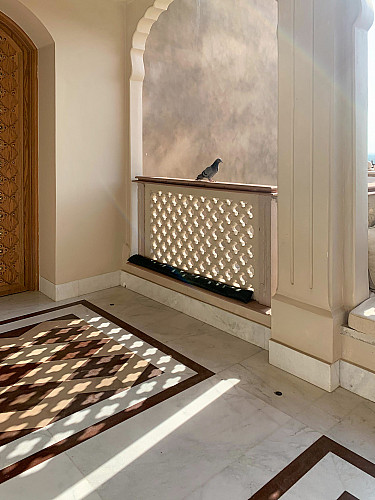
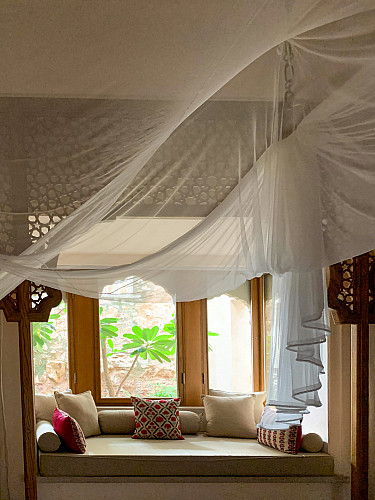
All kinds of soap come in metallic bottles like the one that the sanitiser came in. Everything else is either bamboo, fibre or glass (including the tooth powder that is moulded into tablets). Siddharth Chakravarty, Sustainability Director, proudly affirms the following day that the room is zero-plastic — except for the sliver of plastic film peeking out of the tissue box that I had noticed.
“At Six Senses, our aim is to help you reconnect with yourself, others and the world around you,” I read in my copy of the Little Book of Reconnection that I find on the writing desk. Feeling motivated to find some more reconnection, I fling open the gates to my private garden at about midnight.
Taking the crisp air in, I gaze at the white flower beds and crane my neck to look at the moon outside.
A lizard on the wall stares back at me, visibly upset at the untimely intrusion into its space.
Less out of altruism and more on account of trepidation, I shut the door and rush back into the bedroom. The outdoor shower seems better suited for morning.
Even though it’s a completely new place, sleep comes easily.
Day 2: Rejuvenation
Reconnection with my body is on the agenda for the next morning as I guzzle the yummiest berry smoothie bowl I’ve had in a while along with the Glow Beauty beetroot shot at the all-day dining restaurant, The Cortile, located in the courtyard. Already feeling cleaner on the inside, I walk into the resort’s fitness studio for a session of Vinyasa yoga.
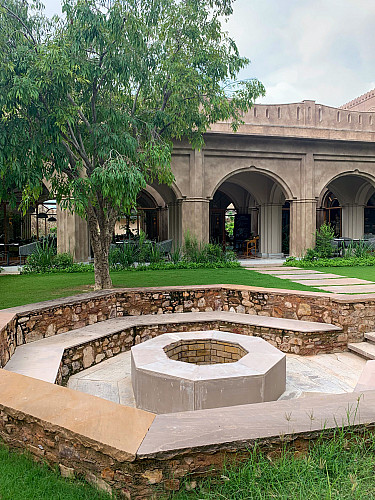
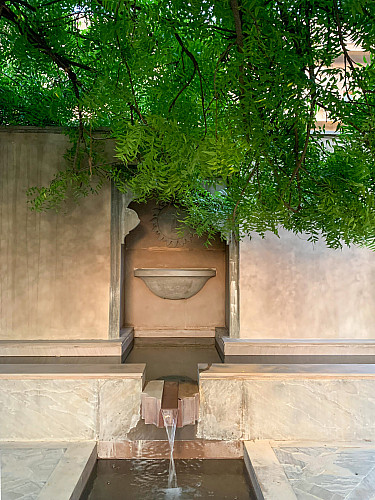
With swathes of gulmohar and jamun trees, the space feels cool and warm at once — luxurious and inviting, like an embrace. The instructor takes me and two other guests through settling breathwork and raises us to a deep stretch. By the time we get to pranayama, I am already steadier and more in sync with my pranic self. With a smile of contentment, I walk out of the room. Through the green leaves and the beautiful magnolias, the sky plays hide and seek. I capture the breathtaking blue as I head over to the Earth Lab, where the resort showcases its efforts to reduce consumption, produce locally, and support communities and the eco-system.
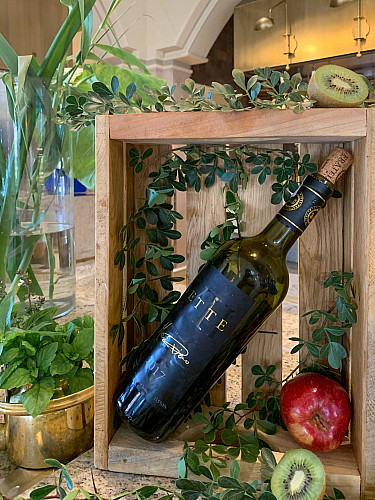
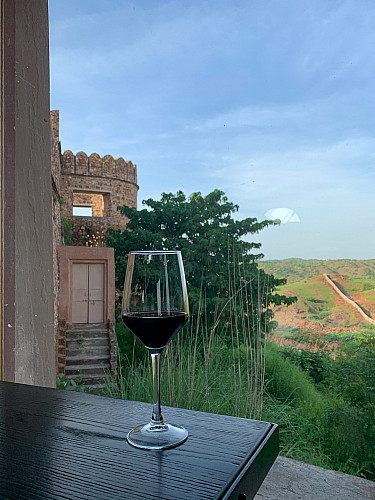
Photographs by Jai Goswami.
At lunch, I meet the effusive Frans who is dressed in a similar locally-made, naturally-dyed Dastkar (local artisan collective) cotton shirt as Siddharth. A Namibian native, Frans speaks about his experiences and draws all his points from his philosophy of “emotional hospitality” and the need for empathy. One can’t help but notice how he addresses all staff members with “my dear”.
Frans offers me palate-cleansing golgappas served with masala pani shots — Siddharth, a Bengali, and I, a Bihari from Bengali-dominated Ranchi, can’t resist bringing phuchkas (a spicier and tangier variant of golgappas) into the conversation. We move to risotto and wine, and Frans sticks to his “green salad” (actually, a gin and tonic with cucumber, but that’s between us!).
In the evening, we are back at The Cortile, and I am led outwards to the giant, grey-tiled dome of a pizza oven. Chef Sanjay Chaudhary is ready with the ingredients, and with a steady hand, he teaches me how to knead the dough, and when to stretch it.
Soon out of the oven, my all-cheese, all-veggies pizza is ready to be cut into about 15 mini slices for the entire restaurant to taste.
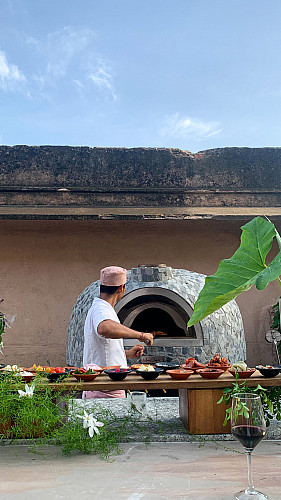
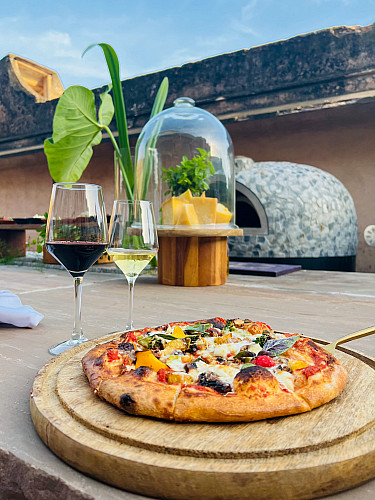
Photograph (right) by Jai Goswami.
Post pizza, I am joined by Siddharth and Shweta for a walk in the garden and to the fort gates. The stone ground beneath us is the same as it has been for centuries and on one of the steps, I spot an ancient inscription that predates Six Senses Fort Barwara. The sky is a lovely concoction of thistle and tangerine as we walk up to the manager’s residence where, to our surprise, we are gatecrashers at a farewell party!
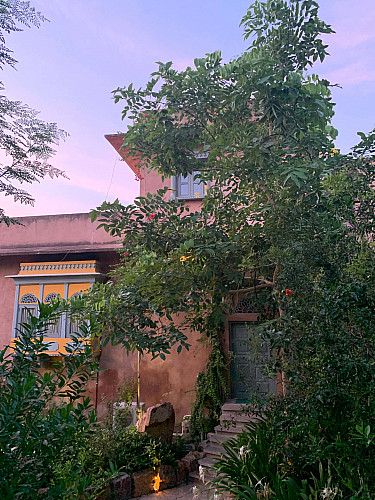
We are joined by the resort’s head chef, Marius Ackermann, and his wife, Suryani, and the Resort Manager Sameer K. Kapoor.
At dusk, we head back to The Cortile for dinner, where we find a mehfil (festive gathering) of local Rajasthani singers, Pawan Rana and Ved Prakash Ranak who serenade us with a happy mix of popular and traditional Rajasthani folk music on their dholak (hand drum) and harmonium.
While munching on a burger that is too big and spaghetti that is easily consumed, we talk about supporting local crafts and discuss our various dreams and ambitions. I learn that Shweta wants to pursue her MBA, and Jai Goswami from F&B is a travel photographer with an awe-worthy Instagram following.
Day 3: Legends, Lore And Liqueur
With history on my mind, I am ready to take a heritage tour of Fort Barwara with Assistant Front Office Manager and resident heritage walk guide, Surya Pratap Singh. A man of many talents, and a gifted storyteller, Surya takes me through the various histories and myths attached to the fort when we meet at the old Shikar Burj, the highest terrace at the property that offers a panoramic bird’s-eye view of Chauth Ka Barwara: “‘Global sensibility, local sensitivity’ is a principle at Six Senses. We have three different kinds of wildlife tours to connect you with nature and local fauna. Besides crafts workshops, we have a village biking trail, and the guava-farm biking trail. We have three kinds of picnics and a liqueur tasting session that takes one through the history of liqueurs and brewing in Rajasthan.”
Mythological origin stories abound about the temple in the village. According to a legend, in 1451, Maharaja Bhim Singh of the Chauhan Dynasty received a divine ordinance from the goddess (devi) in his dream to construct a temple for her. Being a sceptic, the king didn’t immediately respond to the request. Then, sometime during peak summer, he got separated from his troupe and collapsed from fatigue and thirst while out on a hunting trip in the jungle. Miraculously, it began to rain, and on waking up, the king saw the girl from his dreams playing in the forest. He realised that the girl was a divine being and she appeared in her true form, that of Chauth Mata. The king went on to construct the Chauth Ka Barwara temple in her honour. Another legend dating back to 1567, speaks of Rao Surjan Hada, the then king of Ranthambore, who was cured of an incurable disease thanks to Chauth Mata’s blessings. He went on to repair the temple.
“Can you see over there?” Surya points towards the hill overlooking the Shikar Burj. “Since it’s a monsoon-type forest, the whole hill turns green as soon as the first monsoon arrives and stays green until the drought hits.” He tells me how it’s best to spot tigers during peak summer when they step out to find water. I wonder if “spotting” a tiger as a recreational activity reinstates a focus on anthropocentrism and othering. Walking through the fort, we debate the relevance of separate mardana and zenana mahals (men’s and women’s residences) and take in the fort architecture. He tells me more folk tales — that of gulmohur and banyan trees, the paras patthar (philosopher’s stone), and how Ranthambore can find its etymological origins in the names of two friends of its 14th century king, Rai Hammir, Ranya and Thunya. “You might have read why Alauddin Khilji attacked Ranthambore but let me tell you the folk tale…,” he continues as we walk along.
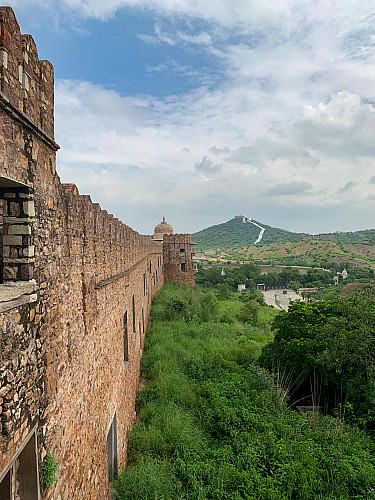
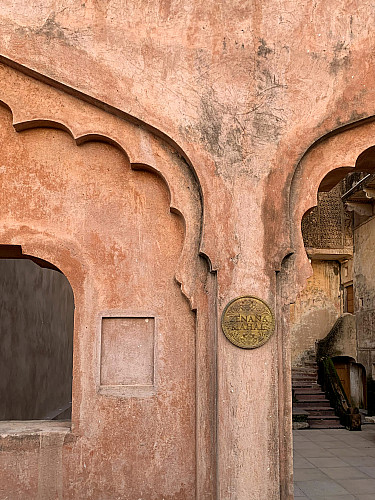
He finally drops me off at the Six Senses Spa and Fitness Centre situated in the zenana mahal, where I meet Dr Jitendra Varshney, the Wellness Director and resident Ayurvedic practitioner, for my wellness consultancy. The clinic of Dr J, as he is called, houses a Chauth Mata idol. Usually, guests go through a machine-assisted wellness screening. However, since I am on medication for my autoimmune illness, we instead choose to identify my dominant doshas. It’s reaffirming to think that all the parts of my being, including my doshas, require nothing but balance. As I wait for the spa session, I flip through their menu of treatments. The opening pages speak about the ways Six Senses hopes to inspire a connection with the body in pursuit of joyful living. While the spa and massages are interesting, it’s their biohacking treatments that pique my curiosity — Six Senses offers six unique and all-natural vibration- and sensation-based methods to enhance recovery processes and improve physical and cognitive abilities.
At 4 p.m., I meet Surya at the rear gate of the fort. It’s the annual Teej festival and historically, on this day, all the villagers arrive at the fort with an idol of goddess Parvati, who is worshipped there and then carried around the village to the lakeside, where men have another special tradition — that of setting clay pots afloat and shooting them (with real rifles!). The villagers are back to their fort after three years of a COVID-19-induced hiatus and it’s a big day for all. An apparent “city madam” (as I am addressed by the children), I am generously invited to the front row to be a part of the puja ceremony. The women click selfies with me and the children wish me “good evening” just as they would greet a teacher.
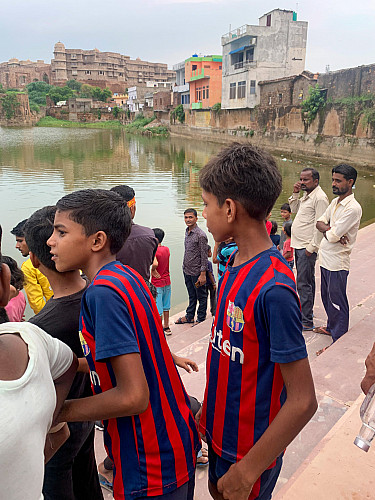
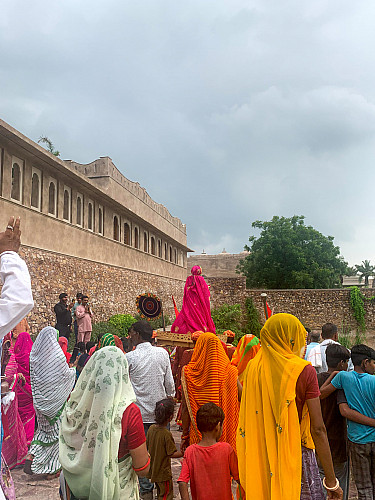
During the sundowner, when I voice my concern about tiger-sighting as a recreational activity to the resort manager, the experienced hotelier introduces me to the majesty of the animal. “Inside the forest, no mobile devices work; it’s just you and the tiger. I have seen people left dumbfounded, amazed, scared, and even lose a little bit of physical control. That’s a moment of admiration and exhilaration that you never forget.”
Pulling my thoughts in a different direction, he talks about how rather than othering, it’s appreciation of the grandeur of nature.
I meet Surya at the library bar in The Rajawat Room, where he has laid out a casket of spices and glass bottles containing pink, green, yellow and clear liqueurs.
“Let’s inspect some of the ingredients on your table. There’s chocolate and these munchies to go along with the drink. Chocolates help you cleanse the palette. Coffee beans help you modify the olfactory sense from one to another one,” he begins.
“The alcohol concentration in these grain-based liqueurs is 42.5 per cent. We have several native wine companies in the country, but we also stand on a long history of brewing local liqueurs. Some are made by tribes, others by monks and pundits. However, the alcohol in Rajasthan is particularly interesting because it was distilled by the royal families.”
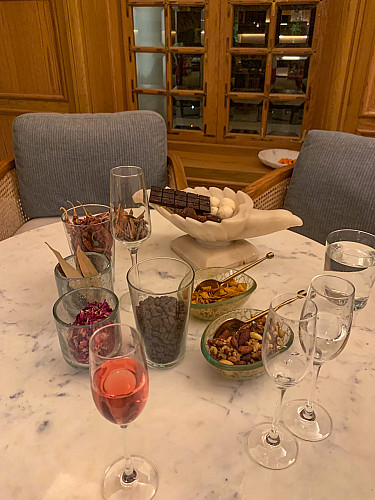
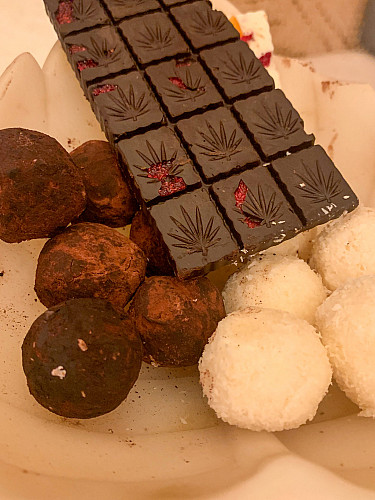
The first liqueur he presents has a paan (betel leaf) flavour. As I sip the herby bittersweetness, he tells me about the various communities around Rajasthan, especially the Kalal community of alcohol distillers.
“Each Kalal house had 30-40 recipes and so we can easily say that the number of recipes coming out of India was large.” Next comes the rose flavour. Surya tells me that these spirits come from the family of Maharani Mahansar in the Shekhawati region and are named after her.
A few more stories and chocolates later, it’s time to go back and pack for my early morning flight from Jaipur. The staff has been kind enough to wrap up a hearty breakfast.
Sleepy but certainly content, carrying all the stories in my heart and my burgundy notebook, I bid au revoir to Six Senses Fort Barwara. I slip the Little Book of Reconnection into my bag, hoping to live more meaningfully with these learnings of transformation that promise a joyful life.
[ad_2]
Source link
Jarastyle – #Notes #Reconnection #Senses
Courtesy : https://www.vervemagazine.in/travel-and-spaces/reconnection-with-six-senses

